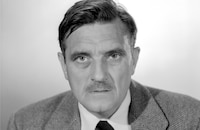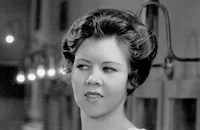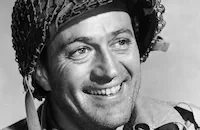The Eternal Sea
Cast & Crew
John H. Auer
Sterling Hayden
Alexis Smith
Dean Jagger
Ben Cooper
Virginia Grey
Film Details
Technical Specs

Synopsis
During World War II, newly promoted Capt. John Madison Hoskins returns home after two years at sea to spend a seven-hour leave with his wife Sue and their children, before taking command of the ship Hornet . When John reports back, he learns that the ship has been sunk and he is reassigned to a teaching position at Quonset Point, Rhode Island, which pleases Sue, who has longed to spend more time with him. Although John feels he is "thousands of miles from the only war he'll get to fight in," he puts his best efforts into the job and produces some of the Navy's top students. Two years later, John is given command of the U.S.S. Princeton . When the ship is needed to spearhead a Philippine invasion, however, the Navy changes its plans and decides to retain the ship's present commander, Capt. William Buracker. John agrees to serve on the ship as prospective commanding officer under his good friend, Buracker. During a sea battle, the ship is crippled and Buracker orders her sunk. John, too, has sustained a severe injury and to save his life, his foot is amputated. Later, at a naval hospital in Philadelphia, while coming to terms with his own condition, John comforts the young sailor Zuggy, who has lost an arm and is being honorably discharged. According to Navy precedent, John's disability makes him eligible for retirement and promotion to rear admiral. Nevertheless, John pushes himself to master his artificial leg and declares that he wants to be the captain of the new Princeton , which is being built in the nearby Navy shipyard. For exercise, he walks to the yard and climbs the scaffolding around the ship. John also develops theories about the use of the new jet airplanes in battle, which would require the ability to take off and land from the carrier ships' short runways. Although Sue is relieved to think that John will no longer be on active duty in wartime, she is troubled that his new interests mask his obsession to remain active and confides to an admiral, who has been John's mentor, that his spirit is crushed by the prospect of retirement. The admiral finds a long-forgotten Navy code, which states that no officer disabled in battle with the enemy can be compelled to retire without his consent and gives the document to Sue, letting her decide whether to show it to John. However, the admiral warns that the Navy will give John a desk job, which might escalate his misery. Two days before a special hearing to dispute his unfitness for duty, John falls from the scaffolding. Although the fall jeopardizes his claim that he is not disabled, John walks into the meeting without crutches and cites the regulation, which Sue has given him. The next day, at the launching of the Princeton , John learns that he has been assigned as its commander. After the war, John challenges the Navy to develop carrier-based jet planes for the protection of the country. Promoted to admiral, John is relocated to San Diego to prepare a demonstration for Navy officials about the capabilities of jets to land on carrier ships. During the demonstration, one of the planes crashes, but John is able to prove that the cause was a mechanical failure, rather than an inability to land in a small space. As a result of the demonstration, John is given command of the carrier division for aircraft operation at sea and joins Adm. Arthur Dewey Struble of the 7th Fleet. Again, John prepares a demonstration of the jets' capabilities for skeptical admirals, this time by flying the lead plane. After all three of the jets land safely on the carrier, the admirals declare that all doubts about the future of jet carrier aviation have been erased and soon after, the jets prove valuable when trouble breaks out in Korea. Later in San Diego, John celebrates a wedding anniversary with Sue, where he is offered the choice of two important jobs that would further his career. John, however, just wants to retire, until he witnesses the return of wounded men by the Air Transport Service from the Korean front. Realizing that he has set a precedent for the handicapped, he is inspired to show the men that they can still lead an active life and turns down both jobs, asking instead to be put in charge of the Pacific Division of the Air Transport Service.

Director
John H. Auer
Cast

Sterling Hayden

Alexis Smith

Dean Jagger

Ben Cooper

Virginia Grey
Hayden Rorke

Douglas Kennedy

Louis Jean Heydt
Richard Crane

Morris Ankrum

Frank Ferguson
John Maxwell
Arthur Space
Dayton Osmond
Roger Broaddus
Mimi Gibson
Arthur D. Gilmour

Tom Powers

Pierre Watkin
Charles Meredith
Howard J. Negley
Harry Lauter
Alan Wells
Robert B. Williams
Alan Reynolds
Tommy Walker
Chuck Courtney
Wayne Heffley

Robert Shayne

Walter Reed
Clark Howat
Richard Shackleton

Roy Roberts
Richard Wessel
Richard Reeves
Bruce Kellogg
Selmer Jackson
Helen Wallace
Alan Dexter

Mary Treen
Sally Mansfield
Grandon Rhodes
Frank Wilcox

Robert Carson

Don Haggerty
Bob Nelson

Willis Bouchey
Harry Harvey Jr.

James Best
Nicolas Coster
Richard Geary
Steve Wayne
William Newell
Jil Jarmyn
Bill Phipps
Howard Price
Bill Hudson
Crew
Lt. Jos. D. Adkins U.s.m.
Fred Allen
Gene Anderson Jr.
John H. Auer
Elmer Bernstein
T. A. Carman
Luther Davis
William Wister Haines
William Hole
Frank Hotaling
Lt. Col. Edw. R. Kandel U.s.a.f.
Leonard Kunody
Howard Lydecker
Theodore Lydecker
Harry Mancke
Bob Mark
John Mccarthy Jr.
George Milo
Adele Palmer
Allen Rivkin
John L. Russell
Howard Wilson
Herbert J. Yates

Film Details
Technical Specs

Quotes
Trivia
Was filmed on board the USS Kearsarge (CVA 33) while on a Show The Flag cruise around Asia.
Notes
The working title of the film was The Admiral Hoskins Story. The following statement, which precedes associate producer-director John H. Auer's credit, reads: "This picture was produced in Hollywood, U.S.A. by the Republic Studio Organization." Auer's credit is followed by a title card stating "This is a true story-based on the life of Rear Admiral John Madison Hoskins" and a quote by Owen Meredith which reads: "That man is great, and he alone, who serves a greatness not his own..." The film ends with a shot of a cross, which is formed by the shadow of a door panel. After the ending title card, a rolling acknowledgment reads: "To the United States Navy, whose bravery has left a lasting impression on the world and in the hearts of their countrymen-and to the Military Air Transport Service and the Department of Defense appreciation is gratefully acknowledged for their assistance and participation which made this picture possible."
John Madison Hoskins (1898-1964) graduated from the U.S. Naval Academy in 1921 and, after earning his wings, attained squadron command in 1937. As depicted in the film, he lost his right foot in 1944 during World War II, while serving as prospective commanding officer on the U.S.S. Princeton. After a new Princeton was built, he became its commanding officer. Later, Hoskin's flagship launched the first U.S. Navy air strikes at the onset of the Korean War in 1950. In early 1951, he commanded the Pacific Division of the Military Air Transport Service, as shown in the film. In 1957, Hoskins retired from active duty.
According to an October 1954 Hollywood Reporter news item and the Daily Variety review, exteriors were filmed aboard the aircraft carrier Kearsarge en route to Pearl Harbor. Although Luther Davis is not credited onscreen, an August 1954 Hollywood Reporter news item reported that he was assigned to "polish" the film's screenplay, which was then in preparation by Auer. April 1955 Hollywood Reporter news items reported that Auer received a citation for meritorious service to the Navy at the film's world premiere in Providence, RI on April 20, 1955. The premiere was also attended by Hoskins and his wife.

Miscellaneous Notes
Released in United States Spring May 1955
Released in United States Spring May 1955











